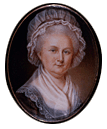

In the late eighteenth century, portraits played a significant role in recalling a person's character as well as appearance, because it was believed that a person's face revealed his or her mental and emotional characteristics. This was especially true for George Washington. A study of his portraits enables us to see him from the perspective of his contemporaries, who regarded him as a man of proven virtues and leadership qualities.
 The portraits made of Washington and his wife Martha Custis during Washington's years as first President of the United States depict them in images that range in size from miniatures to life-size, full-length paintings. The portraits reflect the purposes for which they were made: full-length portraits commissioned by political supporters; waist-length and head-and-shoulder images made to fulfill public demand and artists' ambitions; and miniatures given to family and friends as mementos. The portraits made of Washington and his wife Martha Custis during Washington's years as first President of the United States depict them in images that range in size from miniatures to life-size, full-length paintings. The portraits reflect the purposes for which they were made: full-length portraits commissioned by political supporters; waist-length and head-and-shoulder images made to fulfill public demand and artists' ambitions; and miniatures given to family and friends as mementos.
As President, Washington sat for more than a dozen artists over eight years. He came to find the process time-consuming, and the artists' plans to duplicate and sell their portraits very bothersome. Although Martha Washington was not as frequently portrayed as her husband, she played an important role in the commission of some of his portraits, and was the recipient of the gifts of portraits from artists who hoped for recognition or political favors in return.
Above:
George Washington/ James Sharples / Pastel on paper, 1796/ National Portrait Gallery, Smithsonian Institution
Martha Washington / James Peale / Watercolor on ivory, 1796 / Mount Vernon Ladies' Association

|


 The portraits made of Washington and his wife Martha Custis during Washington's years as first President of the United States depict them in images that range in size from miniatures to life-size, full-length paintings. The portraits reflect the purposes for which they were made: full-length portraits commissioned by political supporters; waist-length and head-and-shoulder images made to fulfill public demand and artists' ambitions; and miniatures given to family and friends as mementos.
The portraits made of Washington and his wife Martha Custis during Washington's years as first President of the United States depict them in images that range in size from miniatures to life-size, full-length paintings. The portraits reflect the purposes for which they were made: full-length portraits commissioned by political supporters; waist-length and head-and-shoulder images made to fulfill public demand and artists' ambitions; and miniatures given to family and friends as mementos.